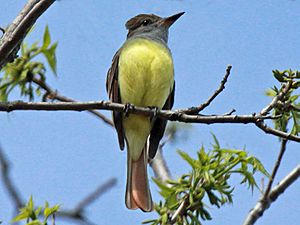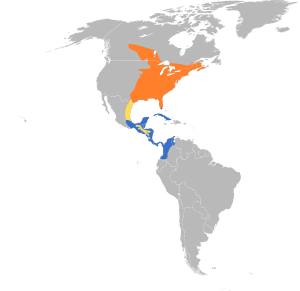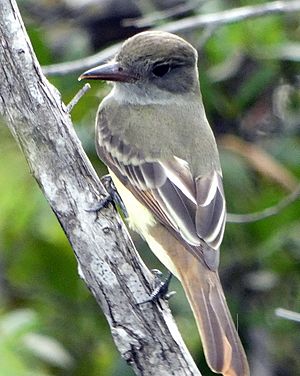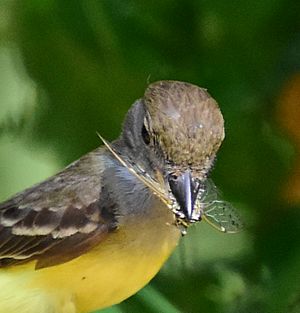Great crested flycatcher facts for kids
Quick facts for kids Great crested flycatcher |
|
|---|---|
 |
|
| Conservation status | |
| Scientific classification | |
| Genus: |
Myiarchus
|
| Species: |
crinitus
|
 |
|
| Breeding Migration Year-round Nonbreeding | |
| Synonyms | |
|
Turdus crinitus Linnaeus, 1758 |
|
The great crested flycatcher (Myiarchus crinitus) is a large, colorful bird that loves to eat insects. It belongs to the tyrant flycatcher family. This bird is very common in eastern and mid-western North America. You'll usually find it high up in the treetops, as it rarely lands on the ground. It's the most widespread bird of its kind in North America.
Contents
Understanding the Great Crested Flycatcher
How Scientists Name Birds
The great crested flycatcher was first officially described in 1758. This was done by a Swedish scientist named Carl Linnaeus. He is famous for creating the system we use to name living things. He first put this bird with the thrushes. He gave it the scientific name Turdus crinitus.
Later, in 1844, a German bird expert named Jean Cabanis created a new group, or genus, called Myiarchus. The great crested flycatcher is now one of 22 species in this group. Its current scientific name is Myiarchus crinitus. The word crinitus comes from Latin and means "long-haired." This might refer to its bushy crest.
What Does the Great Crested Flycatcher Look Like?
Adult great crested flycatchers are usually about 17 to 21 centimeters (7 to 8 inches) long. Their wingspan is around 34 centimeters (13 inches). These birds typically weigh between 27 and 40 grams (about 1 to 1.4 ounces).
Both male and female birds look very similar. They have brownish feathers on their upper bodies. Their undersides are yellow. They also have a long, rusty brown tail and a fluffy crest on their head. Their throat and chest are grey.
Great Crested Flycatcher Sounds
Male great crested flycatchers sing a special three-part song. It has two short whistles: a wheerreep followed by a higher-pitched whee. Then comes a soft, low churr. They sing this song to their mate, especially just before sunrise. This is why it's called the "dawn song."
These birds also make different calls.
- A series of fast, rising huit, huit, huit sounds means they are stressed or excited. This happens when they interact with other birds nearby.
- Their most common sound is a loud whee-eep. They use this to talk to their mates or their young birds.
- If they repeat the whee-eep call quickly, it often means there are predators near their nests or young.
- A quick series of harsh, scratchy sounds signals alarm or stress. You might hear this when birds are fighting over their territory.
Where Do Great Crested Flycatchers Live?
Great crested flycatchers prefer to live in deciduous forests. These are forests where trees lose their leaves in the fall. They also like the edges of clearings and mixed woodlands. They often choose areas with an open tree canopy. This includes forests that are growing back or ones where some trees have been cut down. They tend to stay away from forests with lots of pine trees.
Their Home Range
During the summer, they breed across most of the eastern and central United States. This includes parts of Florida, Texas, Oklahoma, and North Dakota. In Canada, they are found in southern Manitoba, Ontario, Quebec, Nova Scotia, and Prince Edward Island.
For winter, they fly south to southern Mexico and the Yucatán Peninsula. They also go along the coasts of Central America. Some great crested flycatchers live in southern Florida all year round. They migrate to warmer places like Mexico, South America, Florida, and the Caribbean.
Great Crested Flycatcher Behaviour
What Do Great Crested Flycatchers Eat?
The great crested flycatcher mainly eats insects and other small creatures without backbones. These make up most of its diet. However, they also eat small amounts of fruits and berries. Even though they are called "flycatchers," flies are not a big part of their diet. They prefer butterflies, moths, beetles, grasshoppers, crickets, and bees.
These birds use different ways to hunt. Their most common method is to sit and wait. They perch high in the trees and look around in all directions. They often bob their heads while searching. Once they spot a meal, they swoop down. If they miss, they will chase it. They can also stop suddenly and hover in the air. This allows them to pick insects or small fruits off leaves or tree trunks. When they eat fruits, they swallow them whole. Later, they spit out the seeds.
Reproduction and Life Cycle
Nest building starts in mid-April for birds in the southern areas. For those in the north, like Manitoba, it can start as late as June. Great crested flycatchers usually have one mate for the breeding season. They might even pair up with the same bird again in future years if both survive the winter.
The male bird starts the mating ritual. He swoops down from a high perch to get the female's attention. If the female hides, he might hover nearby. He will keep repeating this diving until they mate.
Both parents will look for good nesting spots. However, the female does almost all the nest building. The male stays close by to guard her. They prefer nesting in tree holes or cavities. These can be natural holes or ones made by other animals. They also use nesting boxes and other man-made structures. Most nests are built between 2 and 6 meters (6.5 to 20 feet) off the ground.
The nest itself is built in about 2 to 4 days. It's made mostly of plants like grasses, moss, and leaves. They also use animal fur, feathers, and even pieces of shed snakeskin! Sometimes, they use human items like string, tape, cloth, or plastic. The inside of the nest is about 7 to 9 centimeters (2.7 to 3.5 inches) wide.
Great crested flycatchers lay one set of eggs, usually 4 to 8 at a time. The female bird sits on the eggs for about two weeks to keep them warm. This is called incubation. After the eggs hatch, the baby birds, called nestlings, stay in the nest for another two weeks. Both parents feed the nestlings, mostly insects. The female visits the nest more often to feed them.
Gallery
-
Parida Island, Panama
See also
 In Spanish: Copetón viajero para niños
In Spanish: Copetón viajero para niños









